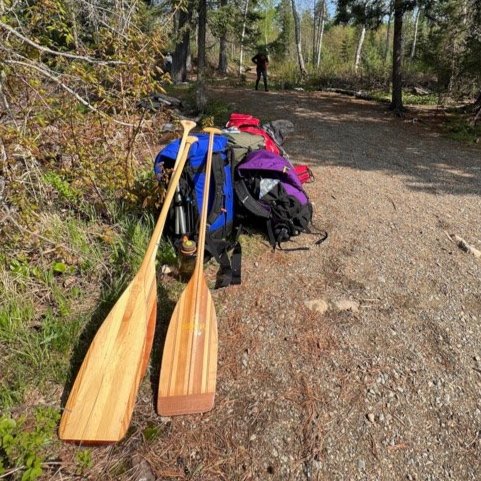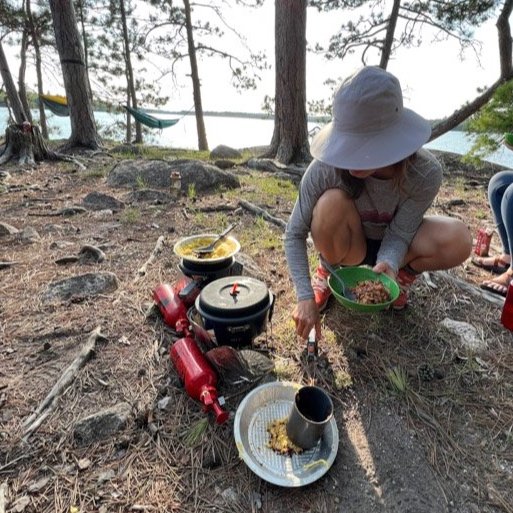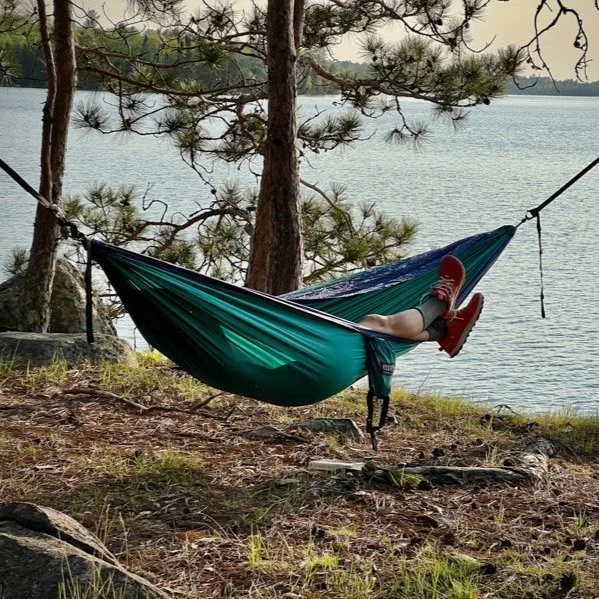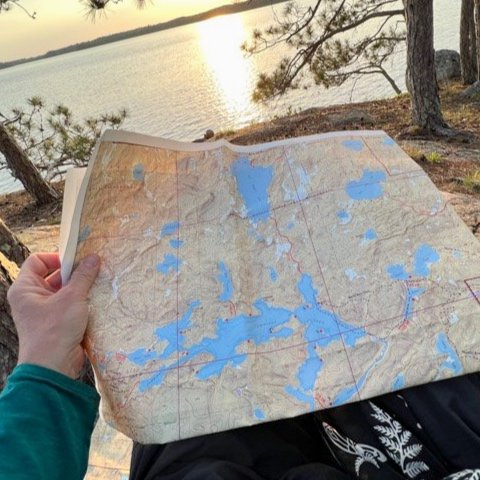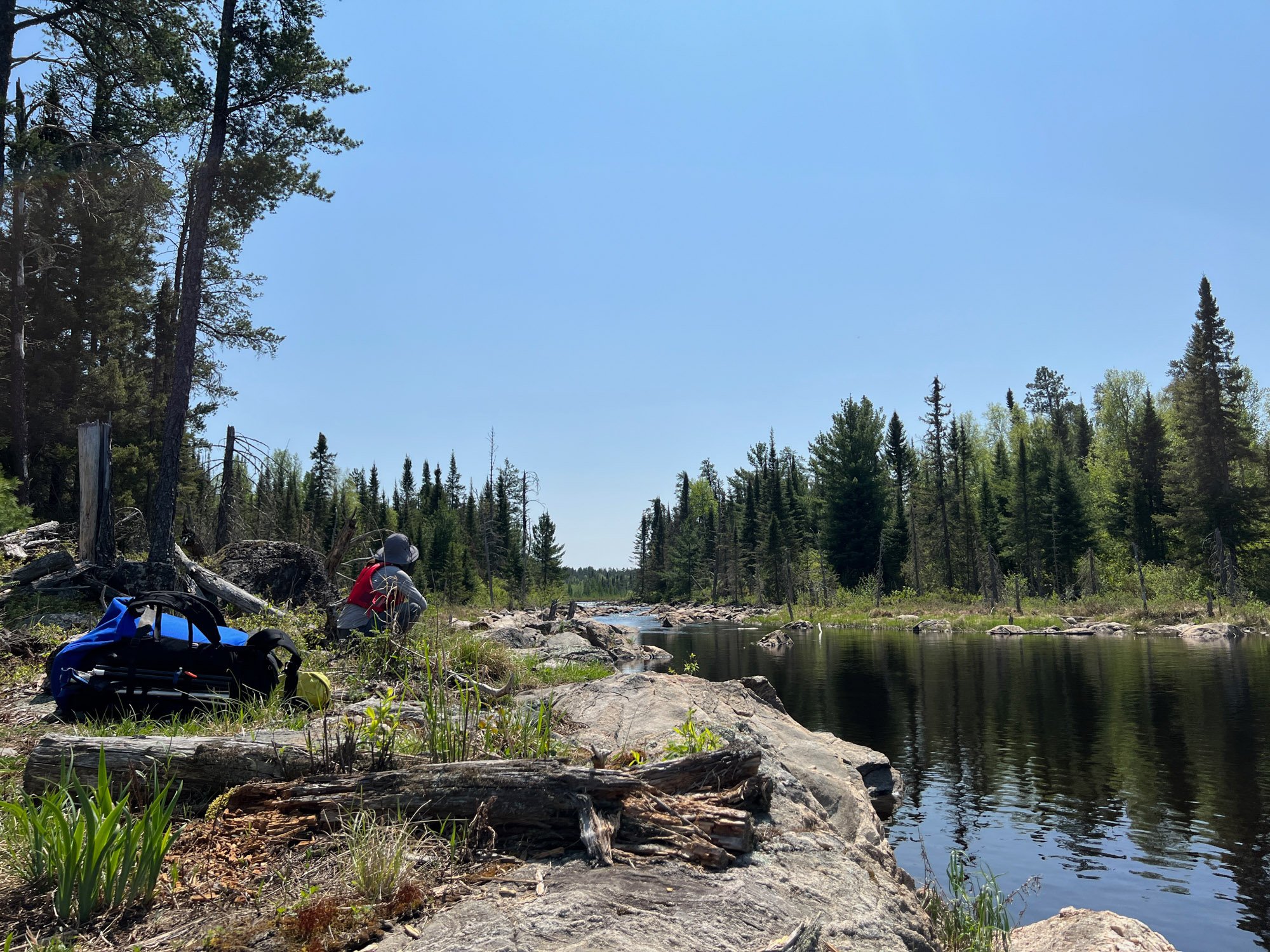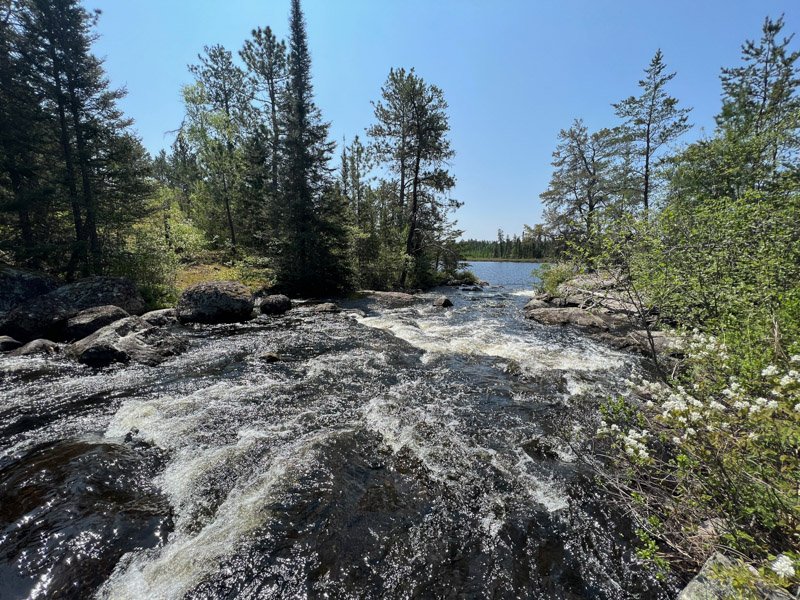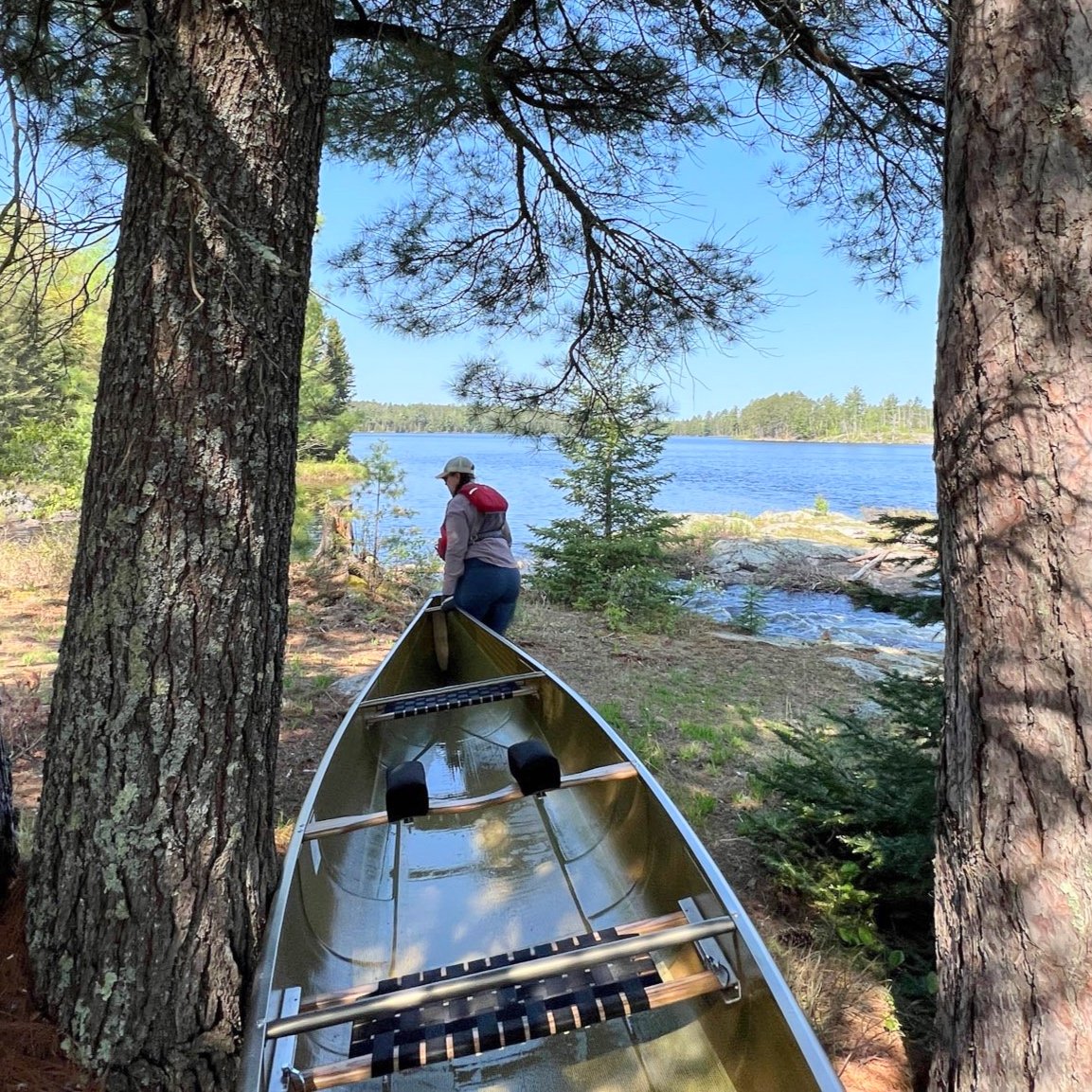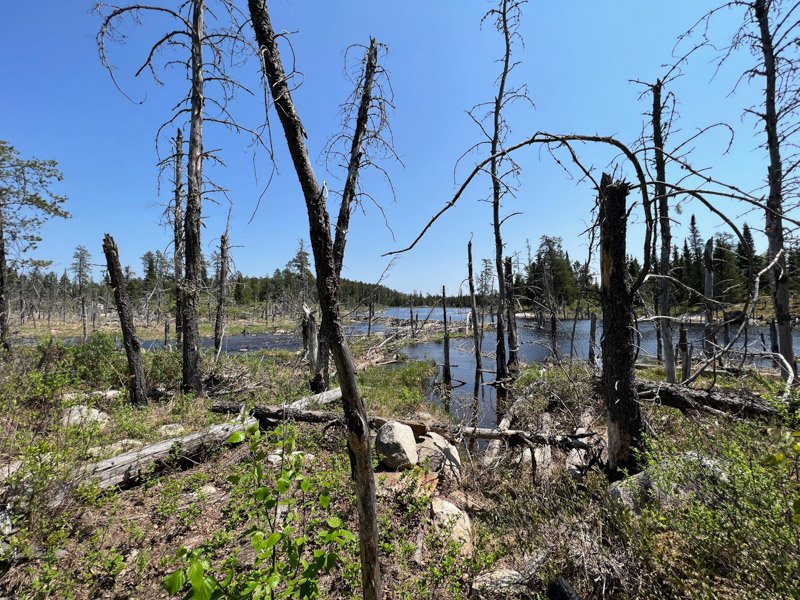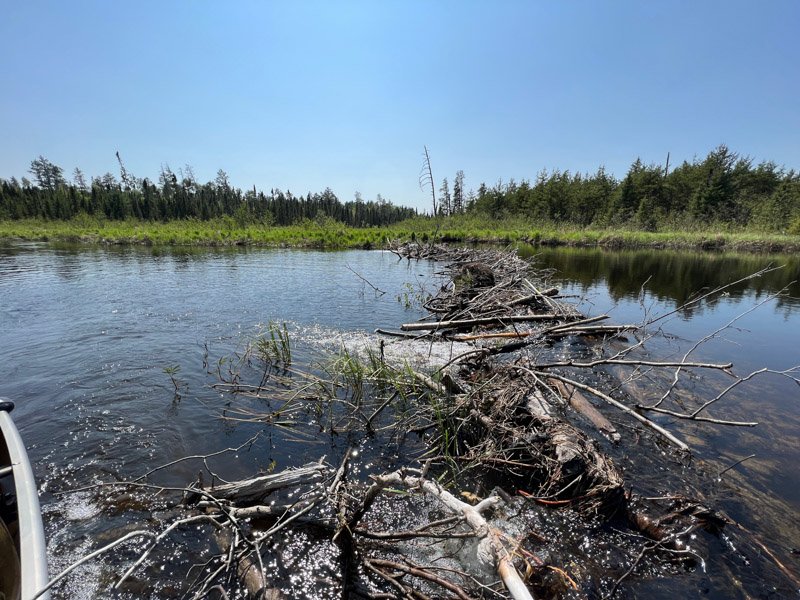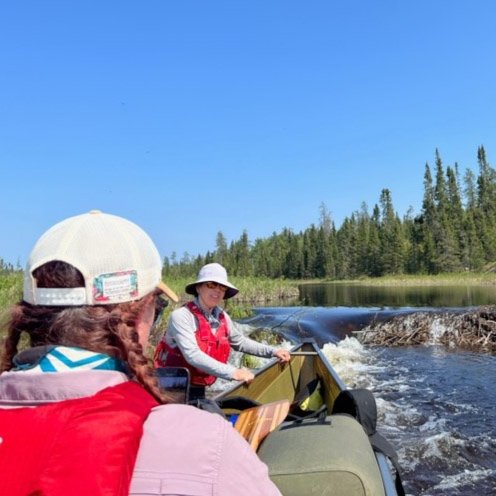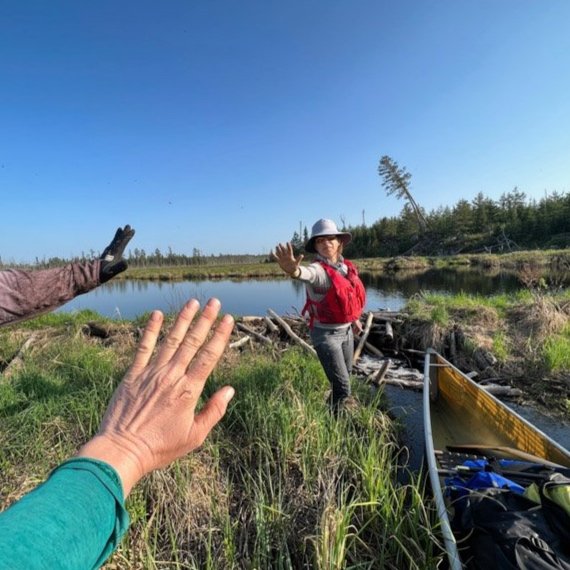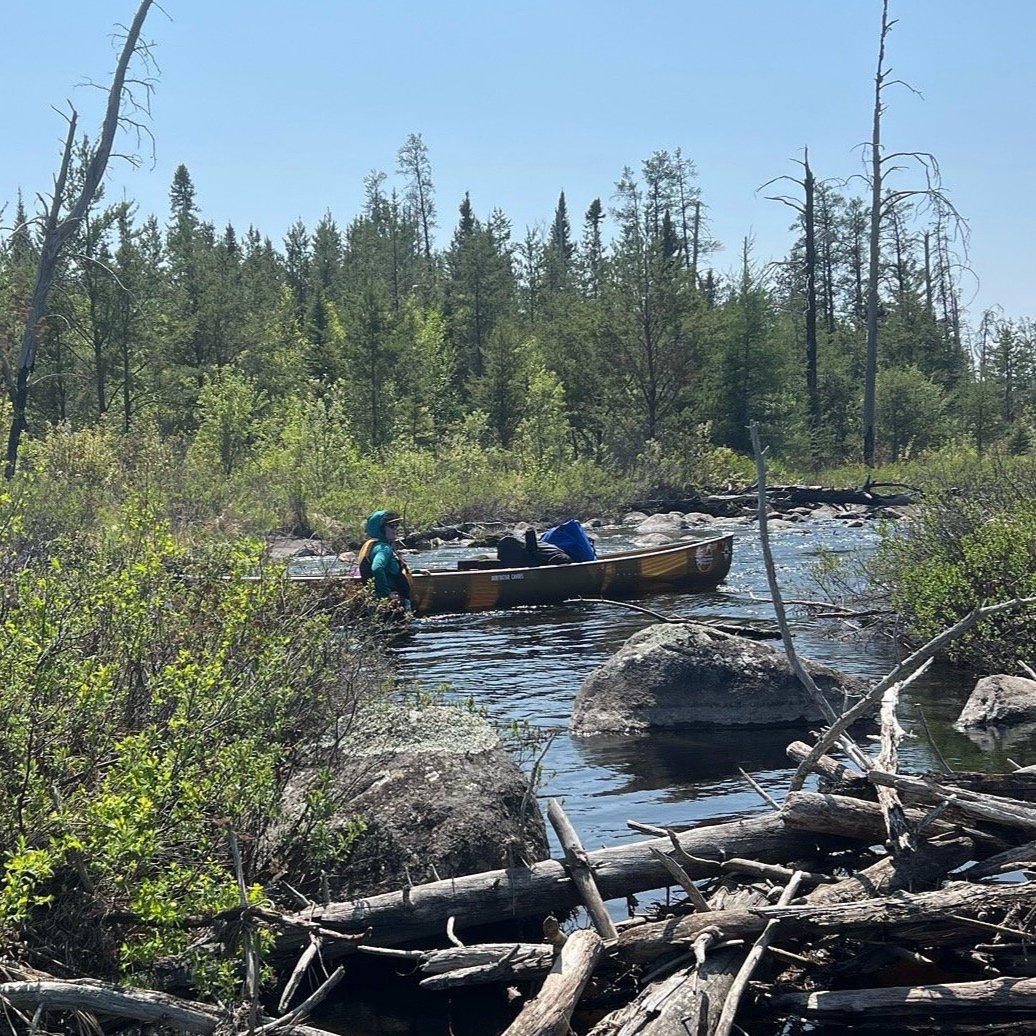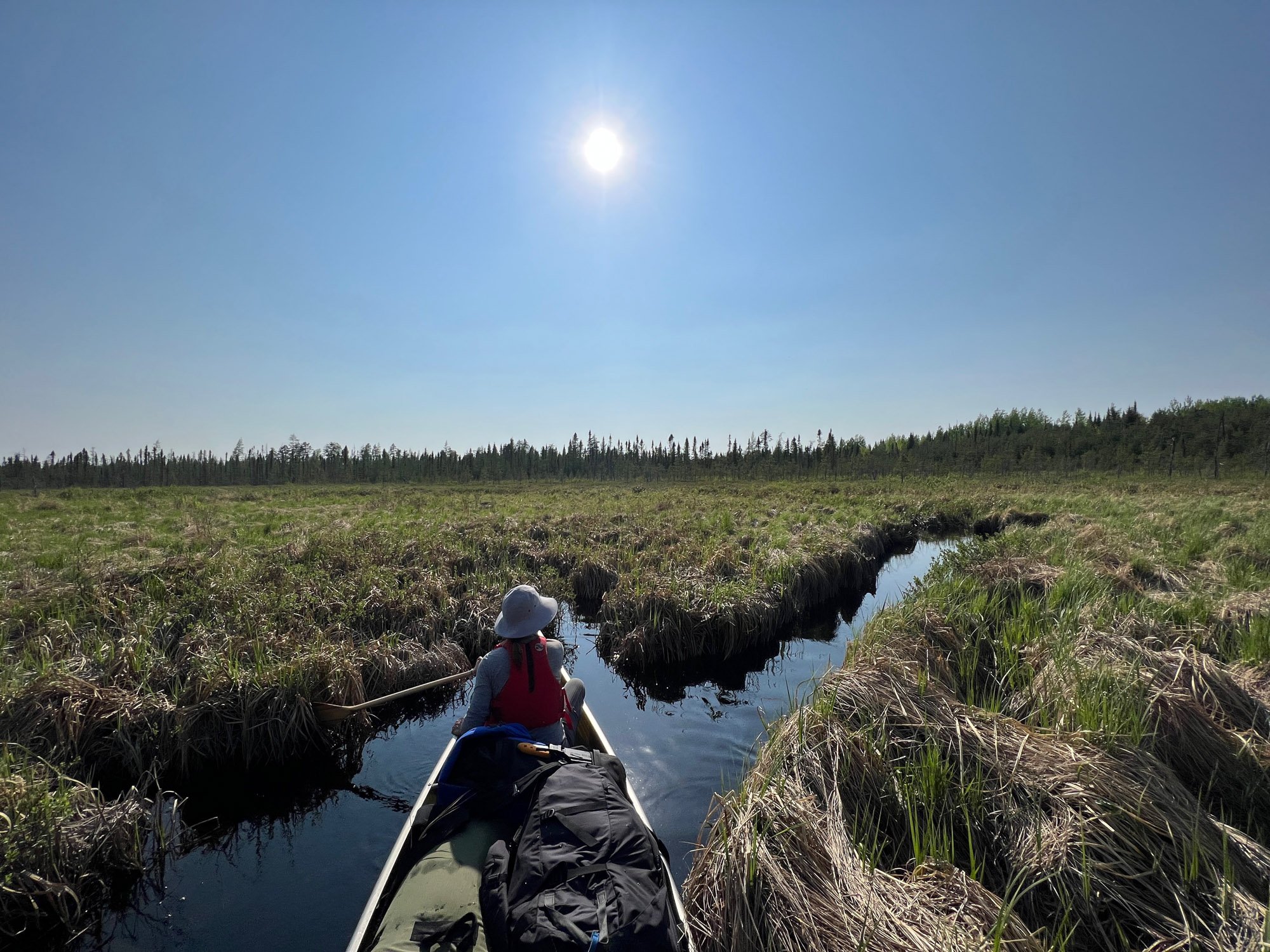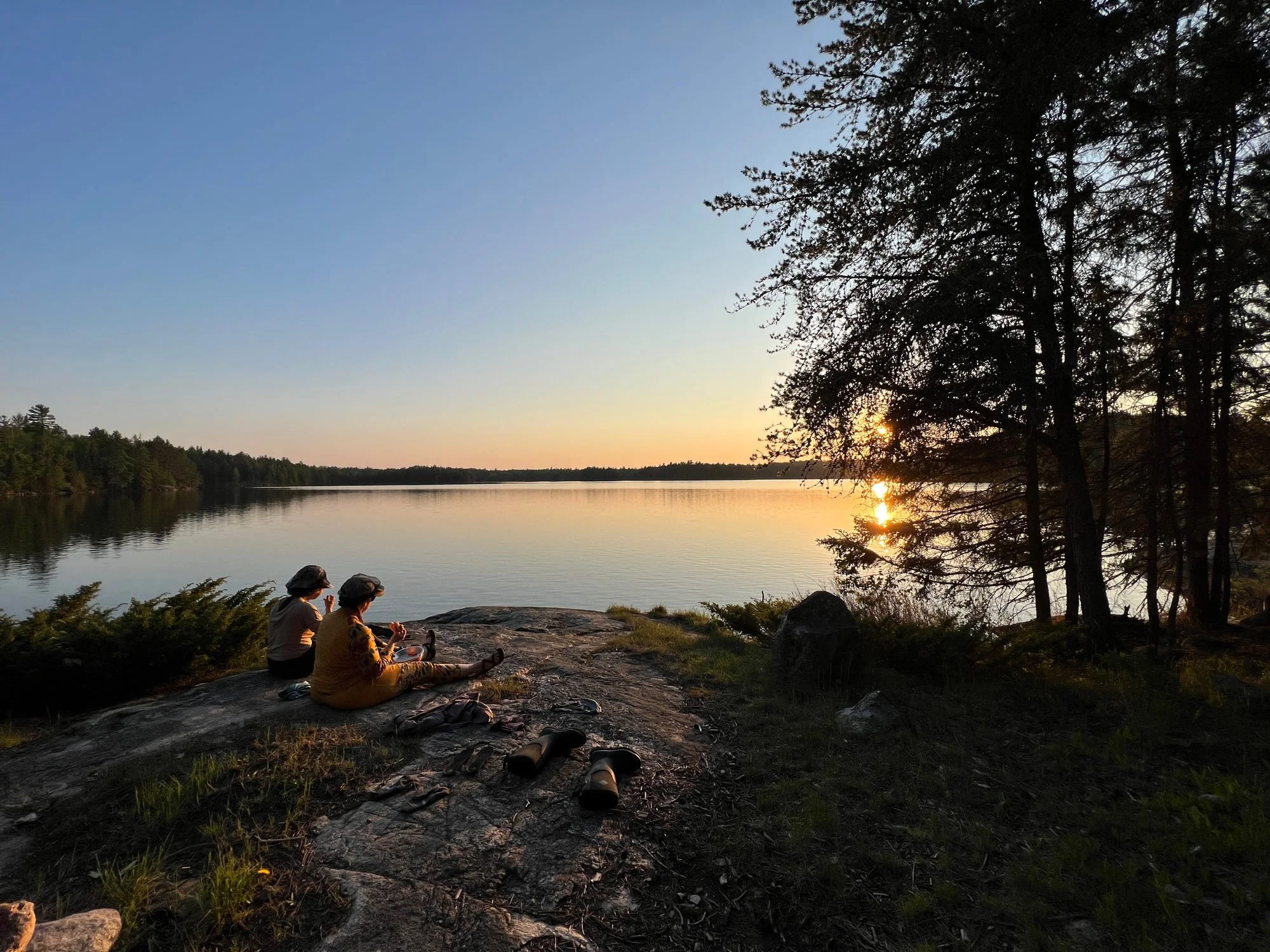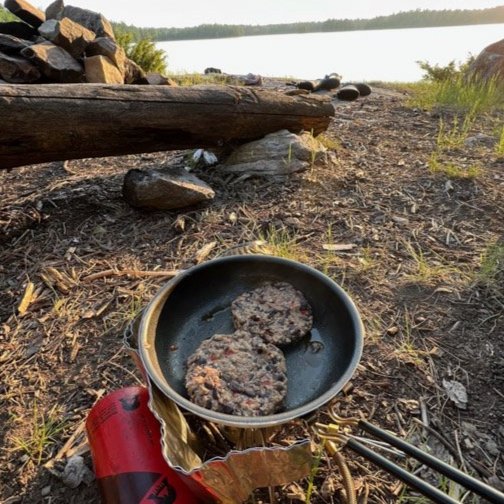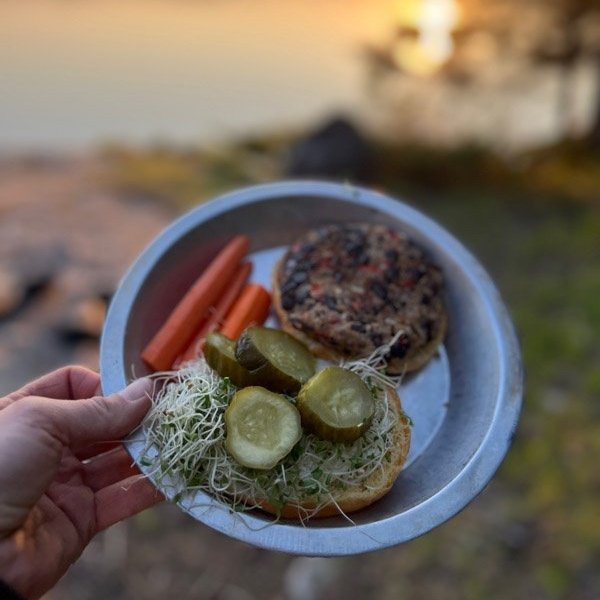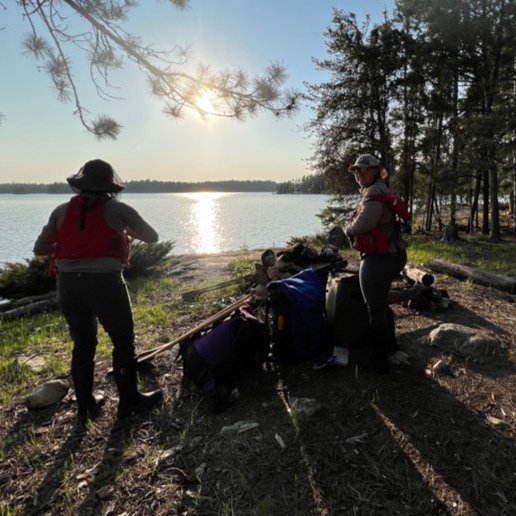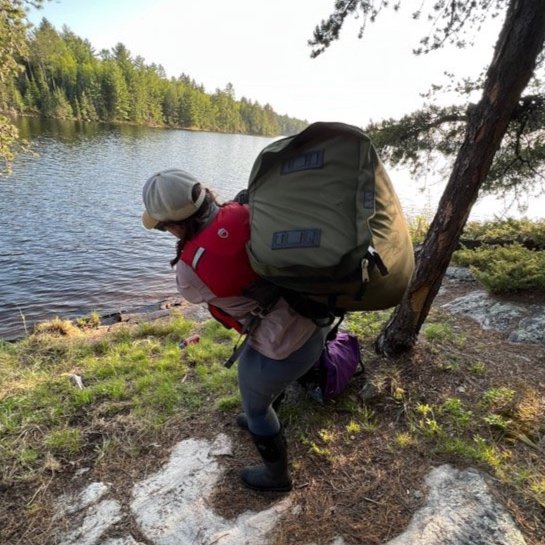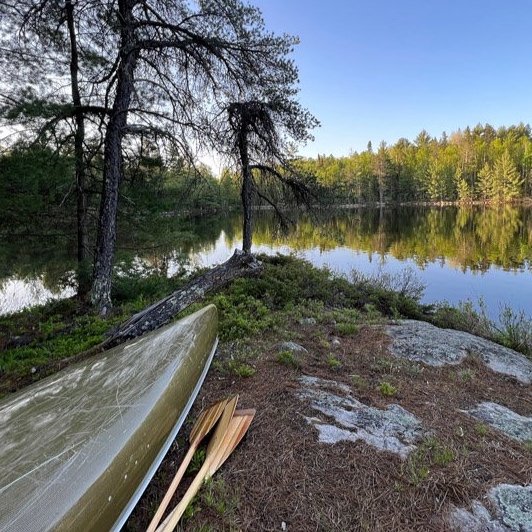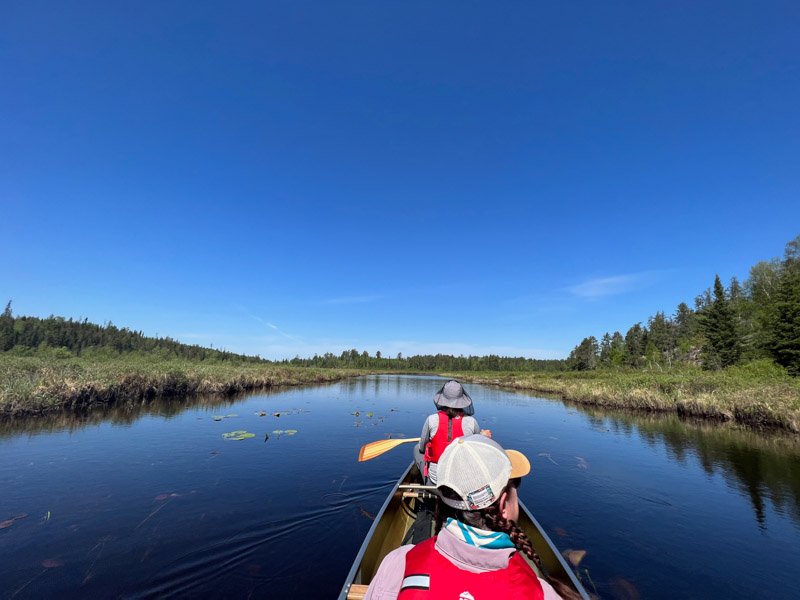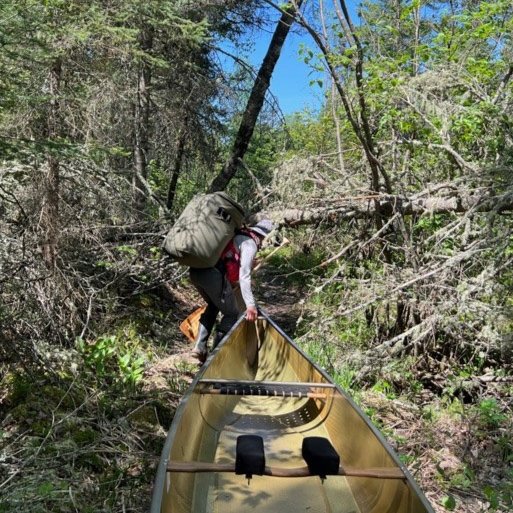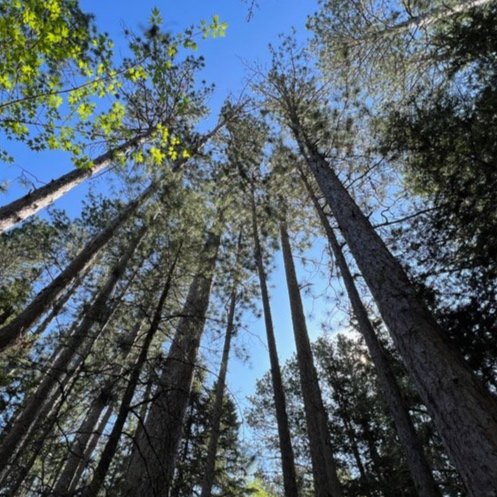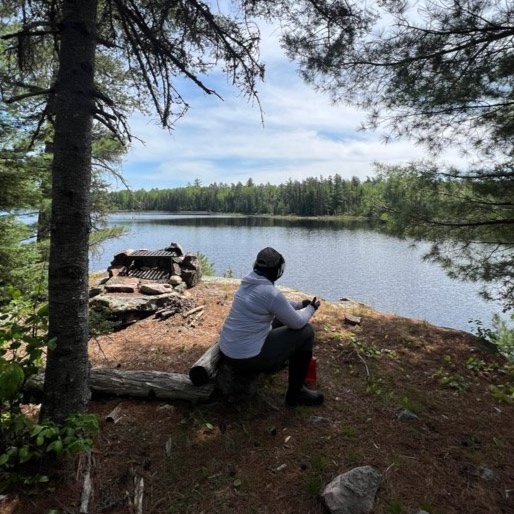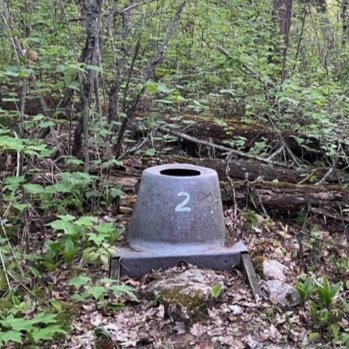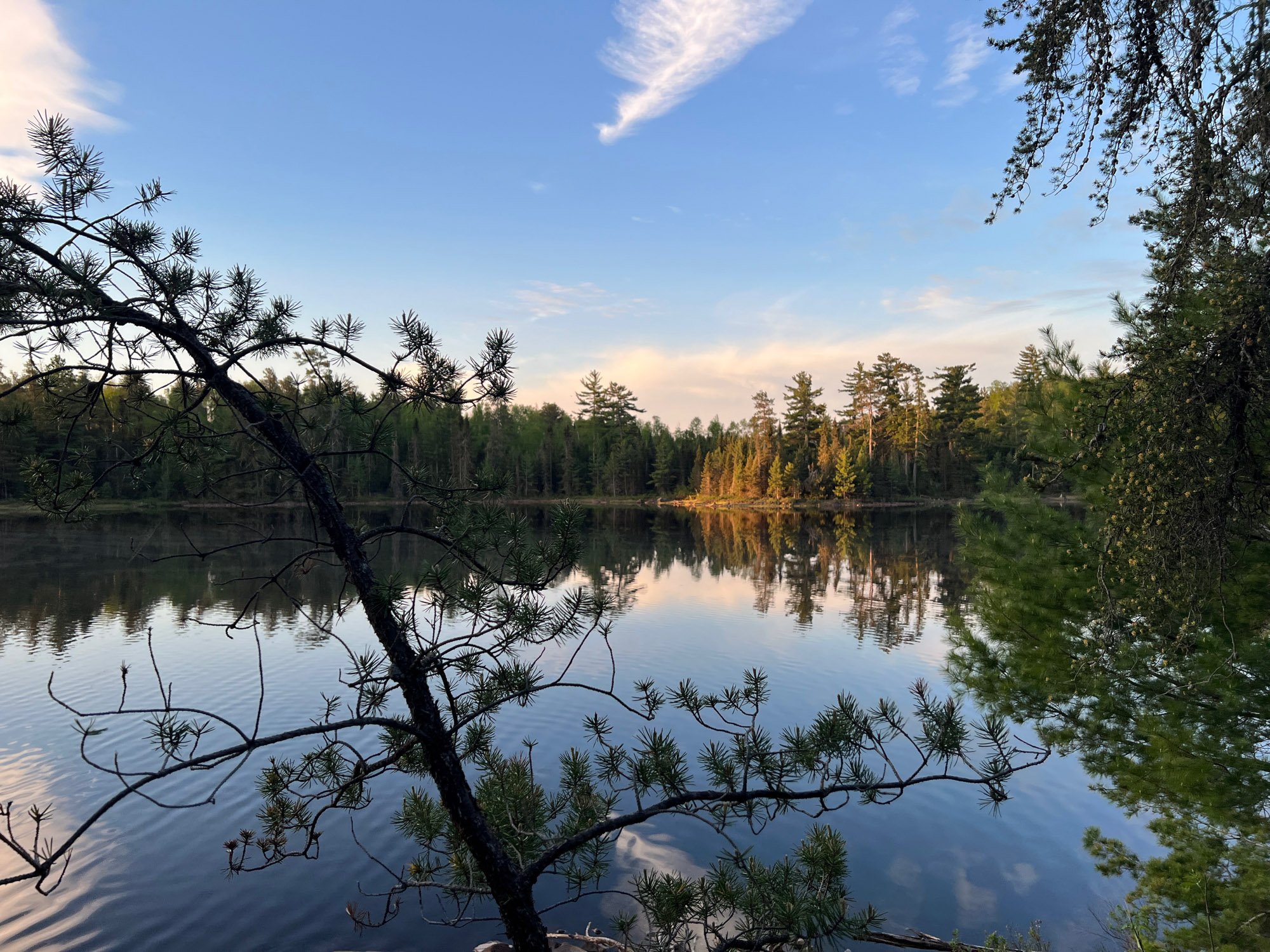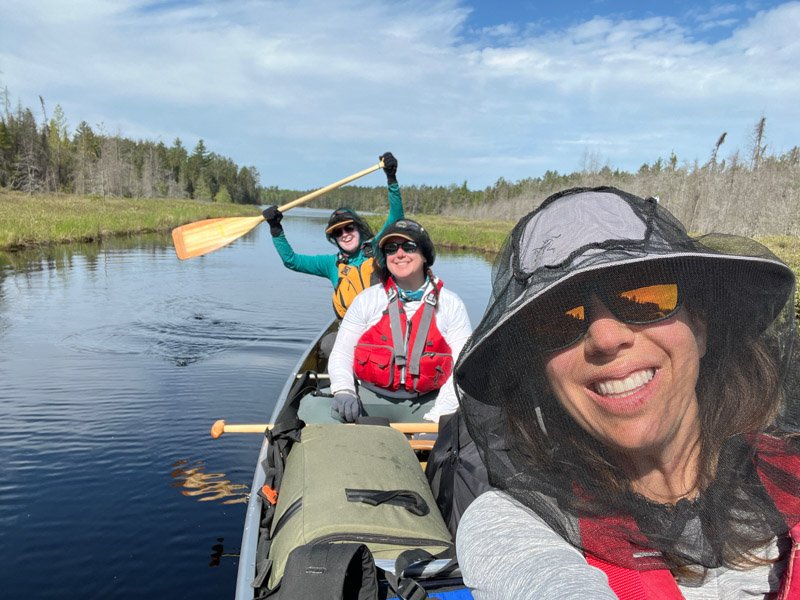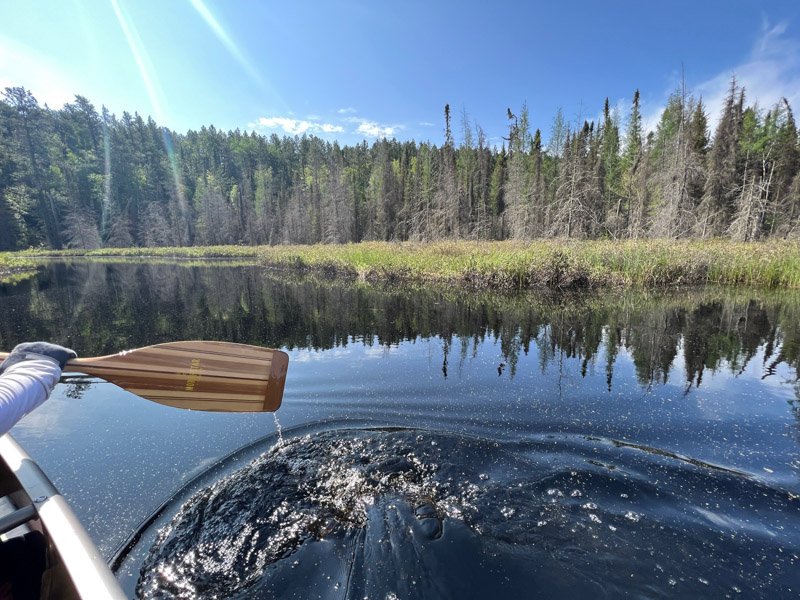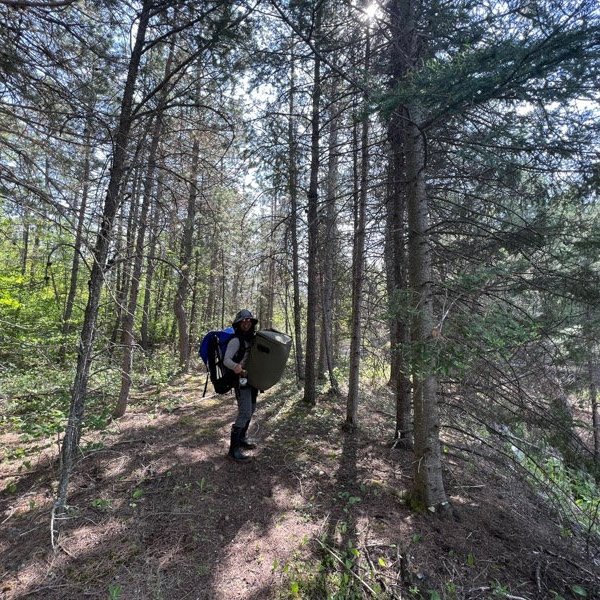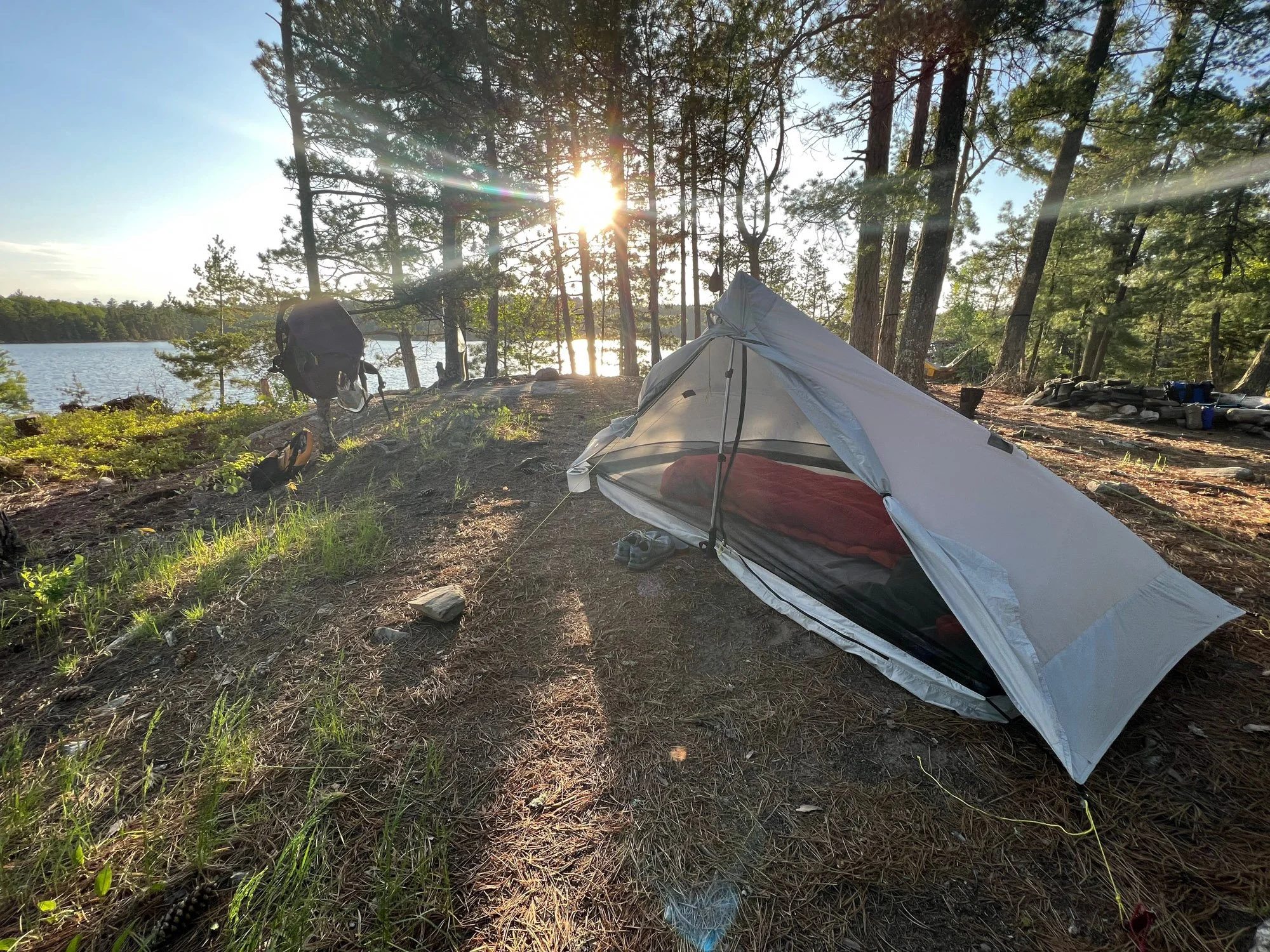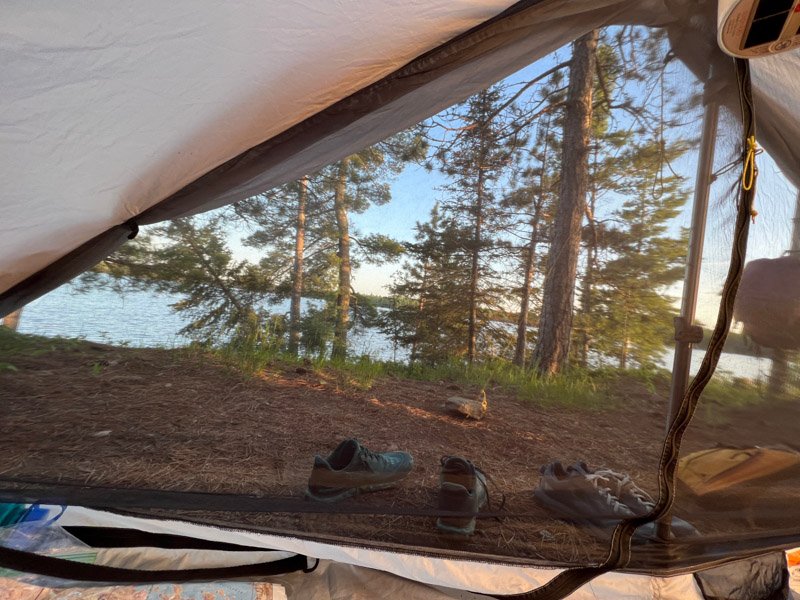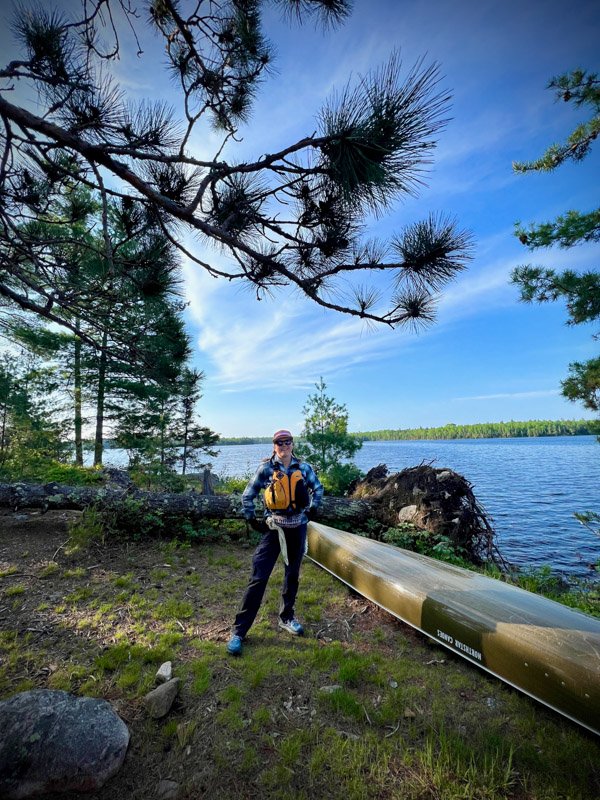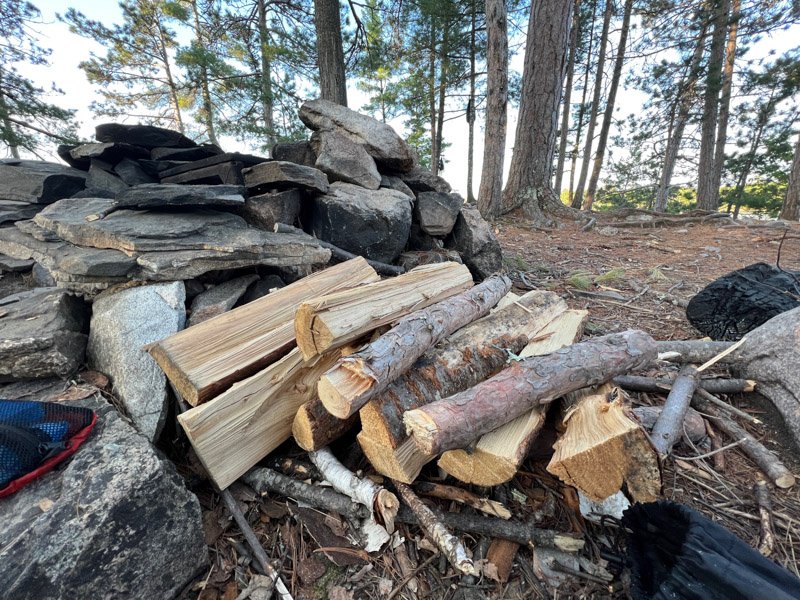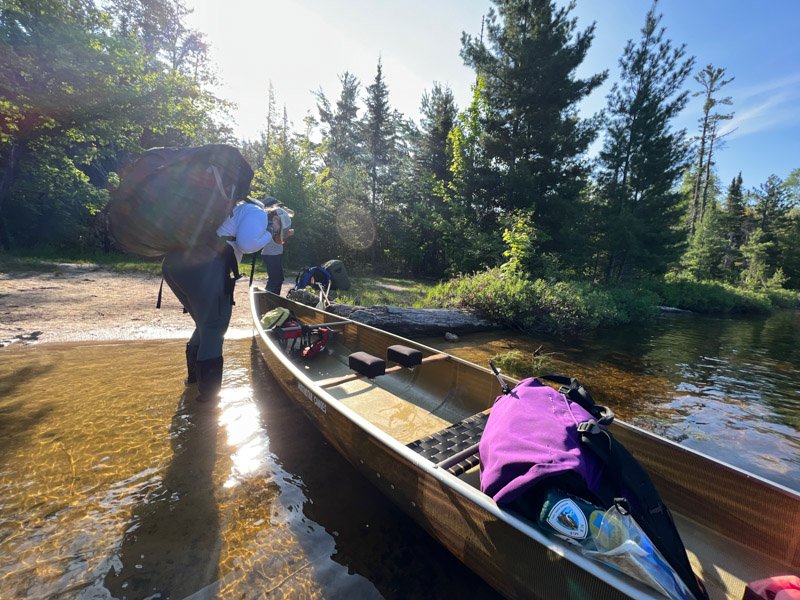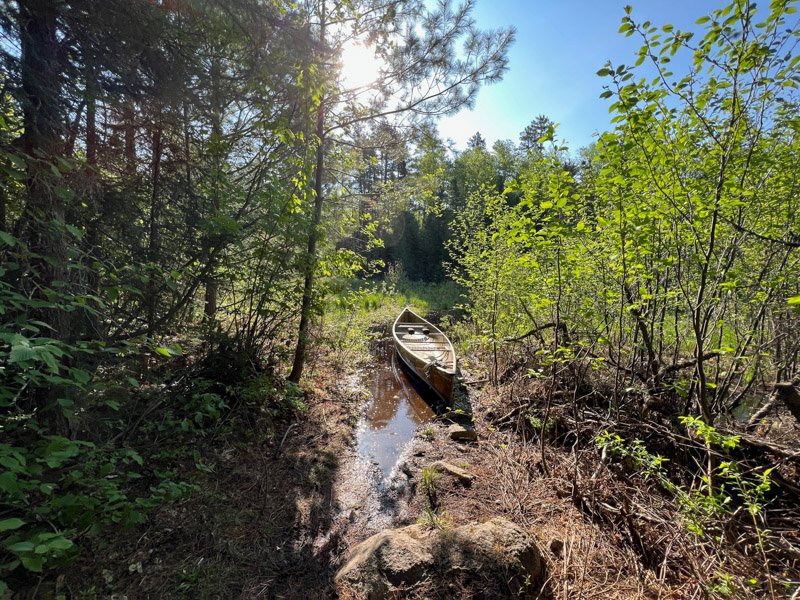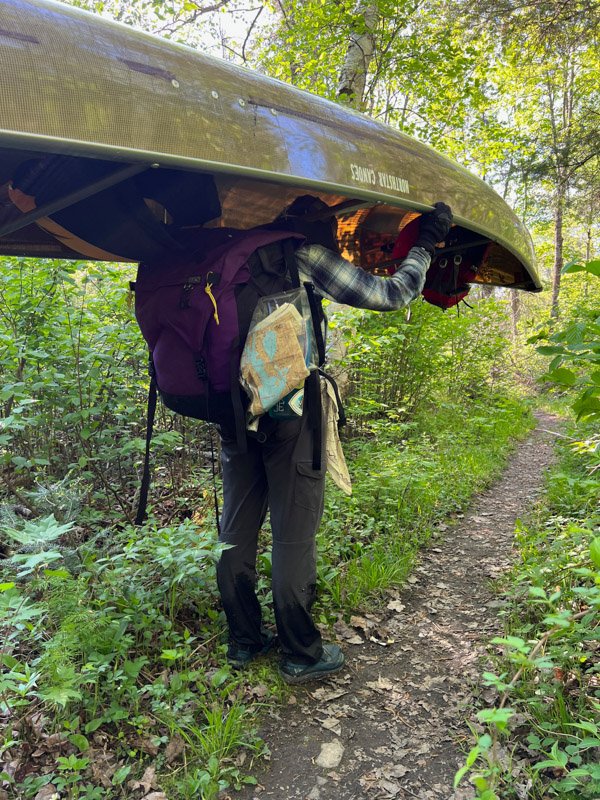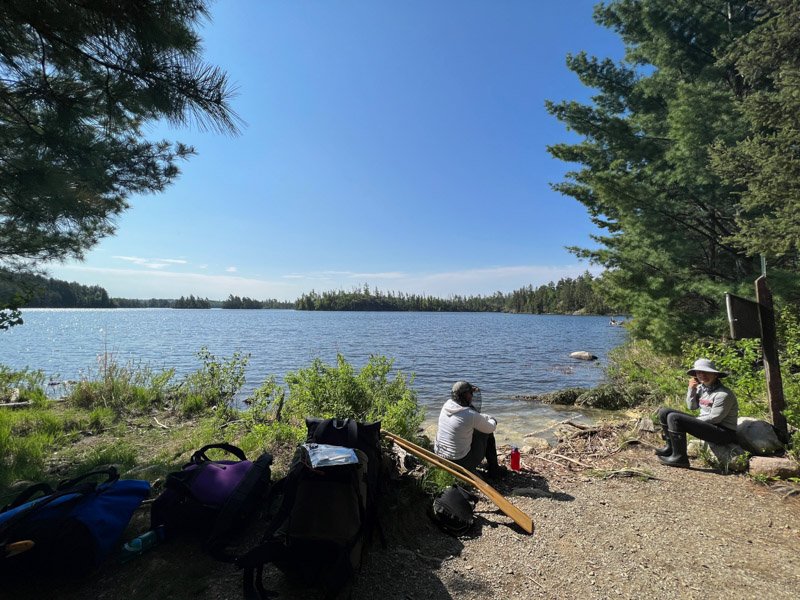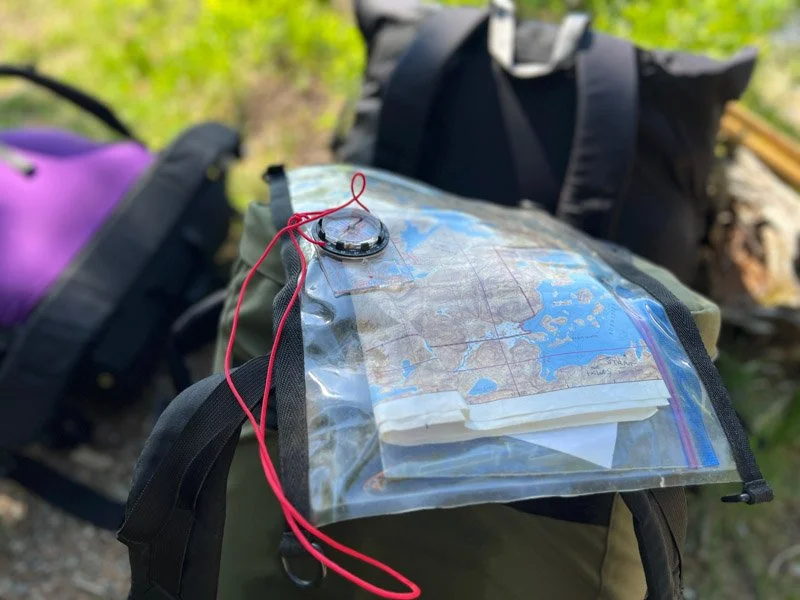The Lost Portages
Pushing through the thick brush, I search for the portage. The sound of the rapids deadens my ears to everything else. I’ve been looking for nearly forty minutes but it’s nowhere to be found. So, where is it? Unusual for a trail to disappear in the Boundary Waters Canoe Area Wilderness (BWCA) where I guide. Most pathways are well traveled, even if a little rough.
Our group of three is in a little traveled river system that snakes thirteen miles through tamarack bog. Beyond the river border stands solid ground blanketed with eighty-foot tall white pine, white birch and thin spruce. It’s nearing 80º; the ground pungent with the scents of cedar, juniper and dried needles.
Months before, I’d read one vague report of someone having come through the area in 2021. The second report I could find dated from 2005. I’m sure people have come through the area since, but I’d suspected that due to the distance, lack of campsites (none exist), questionable water levels and beaver dams, people generally avoided it. But it’s this kind of experience and landscape that I love. The challenges and unknowns.
Pushing through the thick brush, I searched for the portage. It had been nearly forty minutes, and it was nowhere to be found. The sound of the rapids deadened my ears to everything else. So, where was it?
Three days earlier, I had sat in the log building of the Ely outfitter that I work for. The two women that I’d be guiding had driven up to spend the night, go through orientation with me and finish packing their gear. They’d been to the BWCA twice in recent years, joining their friend “who knew what to do” on 4 day trips in well travelled areas. This time they were looking to build their skills in navigation and experience something a bit more challenging. So, they booked a six-day trip with me as their guide.
I knew in advance which entry point we’d be putting in. The BWCA has around 50 entry points, all of which require a permit and allow a limited number of parties through them each day. This is to manage the impact on the land and the solitude and experience for visitors. Because I love to dream and plan, I had been looking at route options for the past few months. The entire area would be new to me—another rare experience—as I’ve traveled many parts of the million acre wilderness in Northern Minnesota. I came up with a few options, knowing nothing would be final until I had a chance to ask my clients questions and get a feel for what they’d like to do. Even then, I’d remain flexible as conditions and preferences may change after the trip has started.
As we’d looked at the large map on the walls of the log building, I traced a potential 50-ish mile route. I had planned for a layover day, as I find that groups like the option of a non-travel day. Plus, it gives us flexibility. I mentioned a few route modifications as I was transparent about my unfamiliarity, save for some basic reports I’d found online. I didn’t know exactly what we’d be paddling into, but my hope was that it would be a mix of challenge, fun, relaxation, all while visiting secluded areas. They were both excited and game to see some country.
Camp 1 | Springtime Solitude
Our first portage is 360 rods; about 1.3 miles long. Many people avoid long portages as they tend to be hot, buggy, hilly, long and sometimes muddy or rocky. It’s not a big deal to walk that distance in your neighborhood, but strap on a 45+ pound canoe pack or a 45 pound canoe, and you will feel it. Carry both, and you come up with a good song in your head to distract you.
Our shoulders feel the long portage as our bodies adjust to the rigors of canoe country travel. I’ve found it essential to train for these adventures as I usually carry a 3-person canoe, the PFD’s (life jackets) and my own 28 pound pack. As a result, I need to be able to carry up to 80 pounds. If the portage is too long or difficult, I’ll carry both as long as I can, dropping my pack at some point along the portage to come back and pick up. For the majority of this trip, we cover the trail three times, once to bring most of the gear and canoe over, once to walk back for any remaining packs, and a final time to carry those packs over to the far landing. It’s known as double-portaging.
We feel fresh and enthusiastic, and the southerly wind is at our back the entire day. The route takes us through four lakes, one river system and three portages, totaling 12 miles with double-portaging. We see one other group and a couple of canoes from a distance, but otherwise the sounds of early spring filled our ears. All but one of the campsites we pass are open. Late May is the height of fishing season; I’d expected to see more people out and about, so I’m pleasantly surprised.
Later, as we cross a large, angular lake, I start thinking about camp. On my topographic maps, I mark potential campsites that sound good based on their location, wind direction and amenities, such as good canoe landings, and ample space to set up tents. I also search for what I think are the most scenic; large sloping rock faces filled with pines, maybe with a small island nearby.
We follow a mile-long peninsula west, towards the end of the lake, and pull up to the campsite. Its layout is just as I’d imagined, with 360º views, a dramatic cluster of tall pines and a great rock face for a swimming spot.
After we unload the gear, I pull out lunch: A creamy salad and crackers. The others scope out the site, finding the latrine, checking out the views and choosing their tent site. The tent pads have a pillowy layer of pine duff, which is the best base for tents as its soft and also keeps them clean.
After lunch, I hang up a pair of six liter gravity water filters for meals and drinking. Next, I fill up our shower bag with water to hang on a tree and heat in the sunshine in case anyone wants a late afternoon rinse.
Finally, I put up my small solo tent, with a beautiful view to the south and hopefully a breeze.
Pulling off most of my hot layers, I jog down to the granite rock by the lakeside. I’ve been looking forward to this all winter. Not thinking about the water temp too much, I take a short running jump into the cold, refreshingly sweet lake. Initially, it’s a small shock, but my body quickly adjusts and relaxes after hours of sweating. I feel giddy. I jump in a few more times, my muscles responding to the refreshing embrace of this remote lake. It’s like getting a bolt of energy that provides strength for the rest of the day. The others chuckle at my play and commit to doing it themselves at some point.
For the rest of the day, the others casually lounge around and explore the campsite. They decide on skipping a campfire, given the heat and bugs this evening. It gives me time to fine tune the setup of camp and organize a few things instead of searching for firewood. Two hammocks are hung, and the women take turns reading and relaxing in them.
The upside of an early spring or summer trip is that we have tons of daylight. Sunset isn’t until around 9pm, which means we can do bigger miles if we choose to and still have plenty of time to relax. The downside is that we don’t really know when the bugs will hatch. So, far we’ve had some gnats here and there but nothing irritating.
Camp 2 & 3 | The Lost Portages
Today’s miles take us into a remote river system with one alternate creek near the middle. This allows us to change course if the conditions are poor or if we’re short on time. Plus, the alternate allows us to skip three miles of what sounds like a challenging portage at the end of the day. I communicated earlier that we’re in for a challenging day; portages would be rustic and we’d likely encounter numerous beaver dams. I semi-joke that it may take us until 9pm, secretly hoping I’m not right. But we all agree it will be an amazing experience.
After a breakfast of Greek yogurt with granola, and assorted toppings like maple syrup and dried fruit, we pack and are on the water by about 8:30am. We paddle about two miles until we encounter a very short portage that takes us past a lovely cascade. With portages short as this, we just 'grab ‘n’ go with the gear. So, two people carry the canoe by the thwarts, as it’s not worth taking the time for me to lift it onto my shoulders. One woman peers closely at the ground points out some owl pellets and a feather we can’t identify.
Pools are extended sections of river with barely perceptible currents interspersed with close stretches of roaring, often unrunnable rapids known as drops.
A short while later, we encounter the first portage of the long river system. It’s full of brush, a couple of downed trees and quite a bit of wolf scat. If I recall right, the darker scat means they’ve recently eaten and it’s fresher. The white scat is older. We spot both color variations. Maybe we’ll be privileged enough to see or hear a nearby pack.
For the next six or so miles, we’re treated to a system of drops and pools. Pools are extended sections of river with barely perceptible currents interspersed with close stretches of roaring, often unrunnable rapids. In our case, none of the rapids were roaring, but all were unrunnable. Alongside these rapids are short portages, usually 40 rods or fewer.
One landing is very close to an old, large beaver dam spanning the width of the river. The map has it marked further south than it’s supposed to be. After a 20 minute search, I decide the landing has to be close to where the waterway spilled over the dam. Sure enough, there it is, tucked in between a half-dozen dead trees. The landing, overgrown, is small and not obvious. Again, we make our way through a general opening in the woods that looks like an old path.
Finally, we near the end of a string of portages. Paddling close to a barrier of branches that lead into another set of rapids, I pull canoe along a low shelf of rock. The presence of a rock cairn suggests someone has recently been here. My other paddler holds the canoe against the rock as I look at the map. It looks as though this is the start of the last portage. The portage seems to be about 40 rods (the map doesn’t say) and ends at a creek that flows into the body of river we are now in. I get out of the boat and start up the slope past the cairn, hoping to identify another scrappy portage trail, but no luck. I weave in and out of the thick woods, hoping to bisect the trail while keeping an eye on the river to stay oriented. After nearly 40 minutes, it is nowhere to be seen. So… Time for a break and Plan B.
After a few minutes, I walk along the shore and scope out the series of rapids until I come to a spot downriver where the water is quiet and safe to paddle.
Heading back to the cairn, I realize I’ll have to line the canoe, then haul everything out of the water and bushwack it downstream. The others grab some snacks and walk along the shore to the eddy where I’ll meet them.
Since I’m definitely not going to shoot rapids with the Kevlar canoe (strong, but precious and prone to scrapes), I decide it will be easiest to bushwhack our gear about 40 more rods down along the shoreline. Easier said than done without a trail. The bank is choked with willow, boulders, driftwood, logs, scratchy pine branches and other small trees. We can’t get too close to the water as there are boggy pockets of muck. We gingerly try to pick the path of least resistance, but getting everything over to the flat water probably takes 20 minutes. Who knows…it feels longer.
Celebrating what we hope is the hardest part of the day, we set the canoe into the gentle part of the river and start making our way west. Occasionally, a beaver dam appears and we puzzle it out for a few minutes, usually lifting our gear, ourselves and the boat over it. The going is easier than before.
One report mentioned over twenty beaver dams, while another mentioned one large one about halfway through. I figured those facts would land somewhere in the middle of correct.
We paddle with the current. Around one curve we surprise a pair of trumpeter swans. One keeps lookout while the other's tail is tipped in the air, feeding in the shallows. We pass floating blankets of bog covered in sphagnum moss rooted with Labrador tea, pitcher plants, leatherleaf and purple iris not yet in bloom. Short, black spruce and tamarack are scattered in the bog. Inland is a wall of white and red pine, interspersed with birch. A songbird is perched on the thinnest twig and we float over the shadowy silhouette of a large fish.
As the day grows long and nearing eight miles, I begin to look for the intersection where a small creek comes in from the south. Satellite maps show the creek still being there, and one old report I’d read mentioned over twenty beaver dams, while another mentioned one large dam about halfway through. I figure those figures will land somewhere in the vicinity of Correct.
The entry into this new waterway is obvious; we notice a current now flowing languidly against us. Our water trail soon narrows and in some places is about as wide as our canoe. The creek continues to snake through open bog and in places, we have to get creative when rounding tight corners. When it’s shallow, I sometimes get out and hand-drive the canoe, as its easier than having three paddle.
Everyone is tired, but continue to be in good spirits through this challenging section. And while there aren’t quite “20 beaver dams”, there are probably around 8 that give us opportunity to troubleshoot getting over them. Each one is like a unique puzzle with its own solutions. Here, we remove some of the packs, and lift the canoe over; at other times everything has to be unloaded. Carefully and not so carefully, we balance our bodies on the floating bog. Sometimes it is easier to walk through the water. It is two miles of a constant problem solving. Our progress is less than 1 mph. Tough going, but the best way to deal with this kind of “Type 2” fun is to have patience. Eventually you do get there. We laugh a lot, encouraging each other along.
A late evening dinner is guaranteed as we reach the two-foot beaver dam about two-thirds of the way through. This is the dam that the report had mentioned. Best of all, it looks as if it was probably opening up into a lake about a quarter mile ahead. One last removal of all the gear and ourselves as we precariously balance the wall of sticks and logs. One last lift-over of the canoe, and we are into a moderately wider river-way. Whew!
It is getting late in the day, nearing 6pm. We’ve done almost twelve miles. The lake has two campsites and because of its isolated location, I am really hoping one will be open, otherwise we’ll face another mile plus portage.
As we come into the main body of water, I squint at the point where the first campsite is located. A minute later two figures pop out of the trees, rods in hand: Occupied. A little crestfallen, I ask them about the other site. In a friendly manner, they mention that a guy had been there in the morning, but they didn’t think he was still there.
We steel ourselves for the possibility we may need to continue further. Past three bays and around one small peninsula, the campsite comes into view. With a massive amount of relief that I know we all feel, it is empty. And it’s beautiful.
Another classic slab of granite fronts the site. Set back just a little from it is a fire grate. The landing is on the south side and the site has 2-3 tent pads with a lovely scattering of pines. Perfect in my mind. There is such a sense of satisfaction finding “your campsite” at the end of each day.
I grab the food bag and get the kitchen stuff pulled out. Homemade veggie burgers are tossed into the pan and start to sizzle. The portable camp table is set with lemon-garlic sauce, pickles, fresh sprouts and carrots. While the burgers cook, I toast up some brioche buns. I don’t think a camp dinner has ever been more satisfying after such a full day. We watch the sun slowly sink as our stomachs are satisfied by the delicious flavors.
Once dishes are washed and food put away, I set up my tent, grateful that it only takes a few minutes and one trekking pole. I rinse my body off, brush my teeth, secure the food bag from critters, check camp one more time and make sure the others are comfortable and settled. The mosquitos are out, but not horrible. I don’t want to donate blood tonight, so I pull off my clothing and jump into my tent. It’s still warm, so I lay on top of my bag, trying to stay cool. Overnight, it gets down to around 55º and I eventually wake up and slide into my bag.
Exploring Westward
After yesterday's adventure, we’re all ready to relax and explore. The others are interested in checking out a large, nearby lake with a stop for lunch at another campsite. Travel will be easy and light, but we take the food pack and any smellies so that we don’t encourage camp visitors. I carry my pack too, as it includes some emergency gear.
On the southwestern side of our lake, a short portage takes us into a lovely, wide river system. Paddling is easy here. The sun warms our arms and the temps are a perfect 75º. A couple of miles later, we cover another short, 40 rod portage. It’s easy, save for the medium tree blocking the trail. We get creative and have one person squat-walk the bow of the canoe under it, followed by me, who does the same with the stern. The landing at the other side opens up to a large lake. We pause on the beach, stretching for a moment. I look at the map and choose a couple of potential campsites back in a bay that might work for lunch.
We find a campsite with a nice elevated view that works for lunch. Our meal has two options. One is a bean and veggie salad, while the other is a creamy salad with chicken. Bread and crackers are pulled out. The afternoon is spent napping, filtering water and relaxing as we watch a couple of boats go by. As this is not a part of our official route, we don’t count them.
Retracing our steps, we head back to camp, covering around 10 miles, allowing us to have a leisurely evening in camp. At dinner, I duck out of a stiff but welcome breeze, to cook chicken and veggie korma with rice.
We’re all sleeping well—including myself, happily, as a full night’s rest has been a struggle for months. I feel rejuvenated every morning. It’s a gift.
Camp 4 | Lonely Lakes
Today’s travel includes shorter miles. By the time we get to the lone campsite on a small lake, it will be just shy of eight miles. We have only four lakes to cover, but the three portages are long. They’re still rustic and technical in places, but not so much as the river system. We encounter one guy and his dog, who gives us a brief hello.
We’re wearing our bug nets more on the portages, as we seem to be stirring up the skeeters. They’re not awful, but persistent. As I carry the canoe on the first portage, I follow a trail of moose poop. It’s plentiful here, and I’m surprised that I don’t see one.
Our last portage landing is grassy and near a boggy area. One of the women is crouched, peering into the grass. She waves us over. She’s discovered a dragonfly hatch.
Along another portage, I see the large bases of a few white pines and pause to appreciate them on my way back when I don’t have the canoe. These clearly missed getting logged and must be at least 200 years old. They’re some of the biggest I’ve seen in the wilderness.
Our last portage landing is grassy and near a boggy area. One of the women is crouched, peering into the grass. She waves us over. She’s discovered a dragonfly hatch. My eyes adjust as I crouch. Suddenly, I see a dragonfly emerge from its brown exoskeleton. It sits for a few minutes, perched on thin grass, letting its wings dry. I stay still as I don’t want to startle it. Finally, it senses some innate signal and flies off, two shinny little wings bouncing up into the blue.
Because we’re on a smaller lake, our regular breeze is a little blocked. When camp is set up, I retreat to the lake for my daily swim. The bugs can’t get me there. When I’m done, I find a small rock to perch on that sticks out into the lake and let the sunshine dry my skin.
We gather near the fire grate for dinner. Tuscan chicken soup simmers and homemade biscuits bake over the stove. One person sits under the bug tent reading while the other wraps themselves in a hammock. The mosquitos are starting to come out in force. When dinner and evening chores are complete, we all head to our tents for relief.
Camp 5 | Boreal Landscape
As we draw closer to more well-traveled areas, the portages become more obvious. Today we’ll cover five lakes, four to five portages and a small river system. We have one longer portage, but we’re getting comfortable with the task, and it’s a delight to cover in the morning. The lakes we pass through all have one campsite. None of them are occupied.
The river system is wide again, making the paddling easy and only has one dam to lift over. We have a good system down and travel efficiently.
Along one portage someone spots Minnesota’s state flower, the Pink Lady Slipper. The small cluster clings to the side of the portage and is such a contrast of delicate beauty in a very wild wilderness.
Towards the early afternoon, we’re back in familiar territory, covering the last two lakes that we paddled through on the first day. We choose a campsite on a point that faces the breeze and has 360º views. All of our sites along the route have been really nice.
The landing is sandy, and we carry the packs up to the main living area. The canoe is hauled out of the water and stored in a safe place, out of the wind. We’re surrounded by Norway pines, but have enough open space for multiple tents. Previous campers have left a nice stack of sawed and split fire wood. Good canoe country etiquette encourages everyone to leave some wood for the next group.
Since we paddled eight miles, we still have most of the afternoon and all of the evening to enjoy. I settle into my routine of gathering, hanging and filtering water. The others pull out lunch and set up their tent.
I lay in the shade, savoring the sounds of the breeze in the pines above me. The needles sparkle and dance in the sunshine.
The latrine takes some time to find, but one of the women find it. I search for it later, and it’s in a confusing spot with a barely obvious trail. I add a few logs to help direct traffic towards the right spot, up a small hill. We leave the TP bag by the latrine trailhead. My rule is that if it’s gone, the latrine is in use. If it’s there, the latrine is open. It saves everyone having to guess and surprise each another.
We all end up in the water at some point, once again being cooled by a large lake. The campsite to the east is occupied, but otherwise all is quiet. Afterwards, for about an hour, I lay in the shade, savoring the sounds of the breeze in the pines above me. The needles sparkle and dance in the sunshine.
Near dinnertime, I head over to the kitchen area, pulling out our two stoves, fuel canisters and the dinner bag. Tonight we’ll have sausage, veggie and bean soup with rustic bread. It’s savory and filling. Hunger has really kicked in, so we’re grabbing snacks before dinner, too.
Even though the bugs are out, the stiff breeze keeps us bug free. The sun glows orange and yellow as it sinks to the west. Tired but happy, I put away the last few things, check the laundry line to see if clothes are dry and secure the food pack. We haven’t seen or heard any large wildlife. Even the squirrels are pretty quiet too.
I relax in my tent, vestibule open so I can see the lakeside. I lay there, taking in the sounds, hoping that they’ll stay with me long after the trip is done.
Camp 6 | Exit Day
I get up early, around 5:30 am, which is the norm for me on trips. I like having a couple of hours to make a hot breakfast and break down camp before we depart. I hear the others stirring, starting to pack up their gear and tent. The air is let out of my pad as I stuff my bag and change my clothes before heading out of the tent. Once out, I brush teeth, use the bathroom and get my pack mostly packed before attending to the main camp.
After the water starts to boil in one of the pots, I fill it with steel cut oats and dried berries. The other holds water for coffee. On the table are toppings that include brown sugar, nuts and berries. A egg crate holds hard-boiled eggs. Sliced kiwi sits in a bowl. Assorted coffees and teas fill the beverage sack.
We’re moving along well, so breakfast is leisurely. When we’re done, the last bits of gear are put away, and water bottles are filled. I slather on some sunscreen and start to haul packs down to the landing. Someone else grabs a pack. Two of us lift the canoe and set it in the water. I hold it while the others load the packs.
Once in, I situate my map, take a bearing if needed, zip my PFD and turn the bow into the gentle breeze. The lake only has a riffle, but wind and thunderstorms are expected later. This motivates us to get off the water by mid-morning so that we can avoid getting caught in poor weather. Far off to the east, we can see thunderheads building. But their sorbet tops belie their dark, threatening bottoms.
After a mile, we coast into the only portage landing we’ll do today. It’s an easy exit as it’s flat and mostly sandy. I grab my purple pack, hoist the canoe to my shoulders and jog down the gentle grade to a pond. Maybe I’m feeling horse-to-barn, or I’m just feeling strong, but it's fun to move at a faster pace. The tread is easy, but I keep an eye out for the random root or rock. A third of a way through, we encounter the small pond again. In about five strokes, we’re across. This is all familiar territory. The second part is a bit hillier and more technical, so I move at the pace of both jog and walk. I make it to the end with the pack and canoe. Since more people come through here, the staging area where we set our packs is ample and filled with soft duff. The others relax while I jog back for the food pack, which is significantly lighter since six days ago.
None of us want to leave the wilderness and try to capture the warmth of the sun and the feel of rough ground beneath our feet. Before we push off into the large lake, we linger, knowing we have enough time for some last sips of lake water and a few snacks. Chatter consists of everything except going home.
Our shuttle will meet us by 11:30am, so we slowly load the canoe, shift the packs and head out. One of the women wants to navigate. Throughout the trip, I spent time teaching her the basics of navigation, and she’s been practicing here and there. She’s doing a great job.
We meander through the large lake dotted with islands as the canoe follows an unseen pathway. Some of the islands hold small hundred-year-old cabins. Other islands are silent guide posts of Canadian shield and patches of earth packed with trees.
We begin all the lasts of this adventure.
There is one exposed section water that we must cross. Checking the wind direction and pointing the bow into the waves, we head towards the far shore. The landing is invisible, but we know its location by the float plane that bobs in the water nearby.
The time is 11:15am as we pull up to the busy boat landing. Jarred by the sounds of a truck moving a dock and other equipment, along with cars topped with canoes parking and leaving, we sit for a minute, startled at being back in “civilization”.
We begin all the lasts of this adventure.
The canoe is unloaded.
The packs are carried to the car.
Life jackets are unzipped, and before we leave, we take one last gaze at the dancing of blue.
Our minds try to grasp it all and cram memories into hearts that won’t hold them. Nearly sixty miles of adventure to dream about as we drive home.
